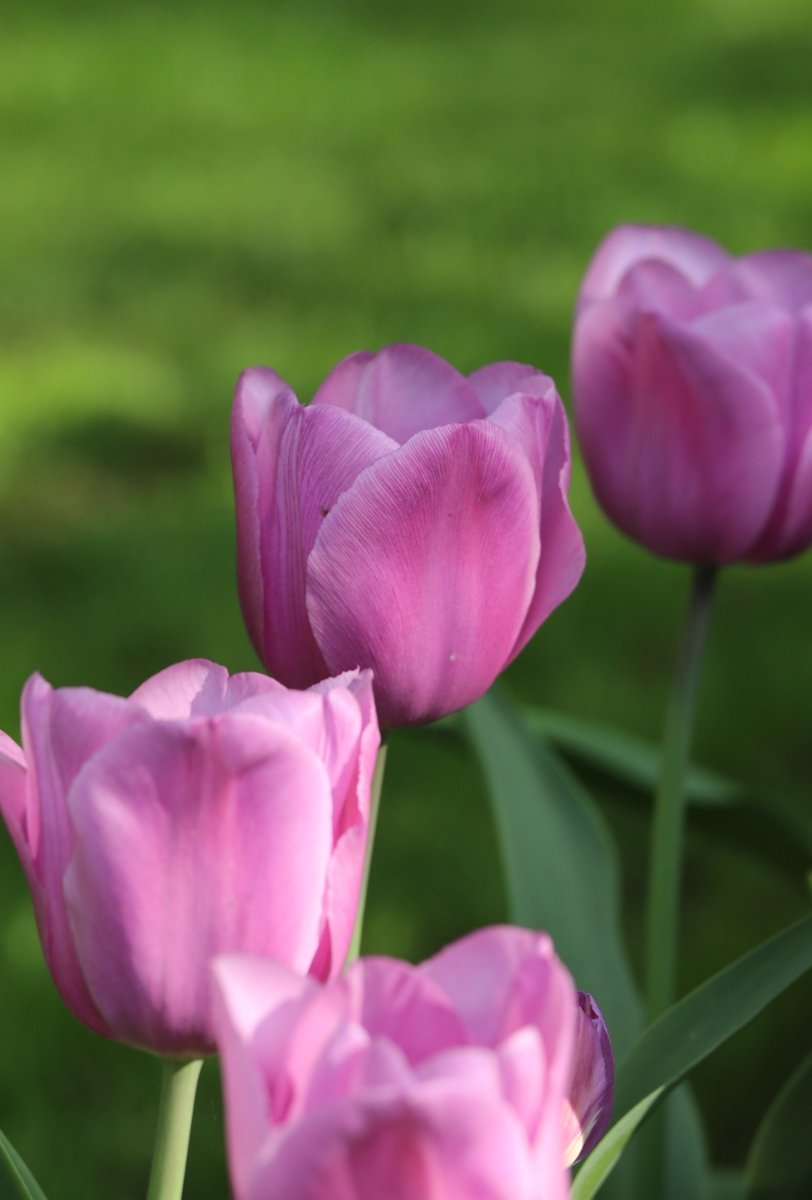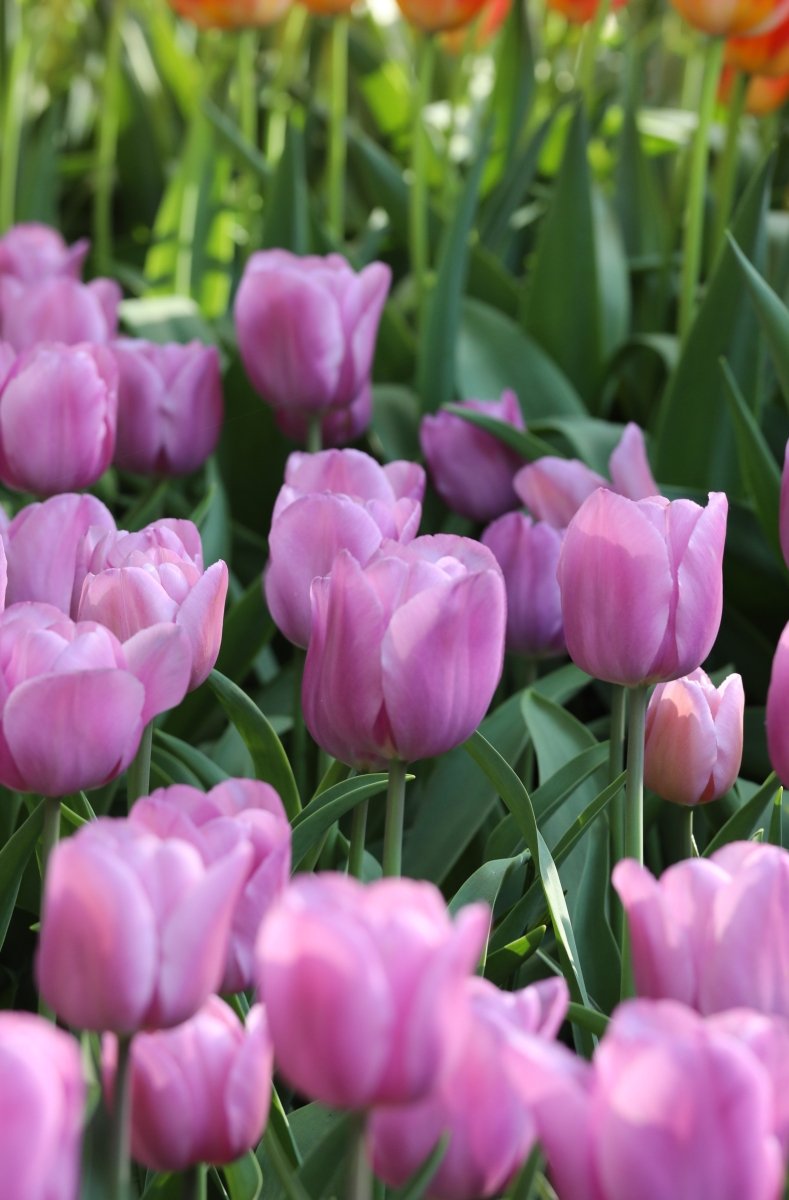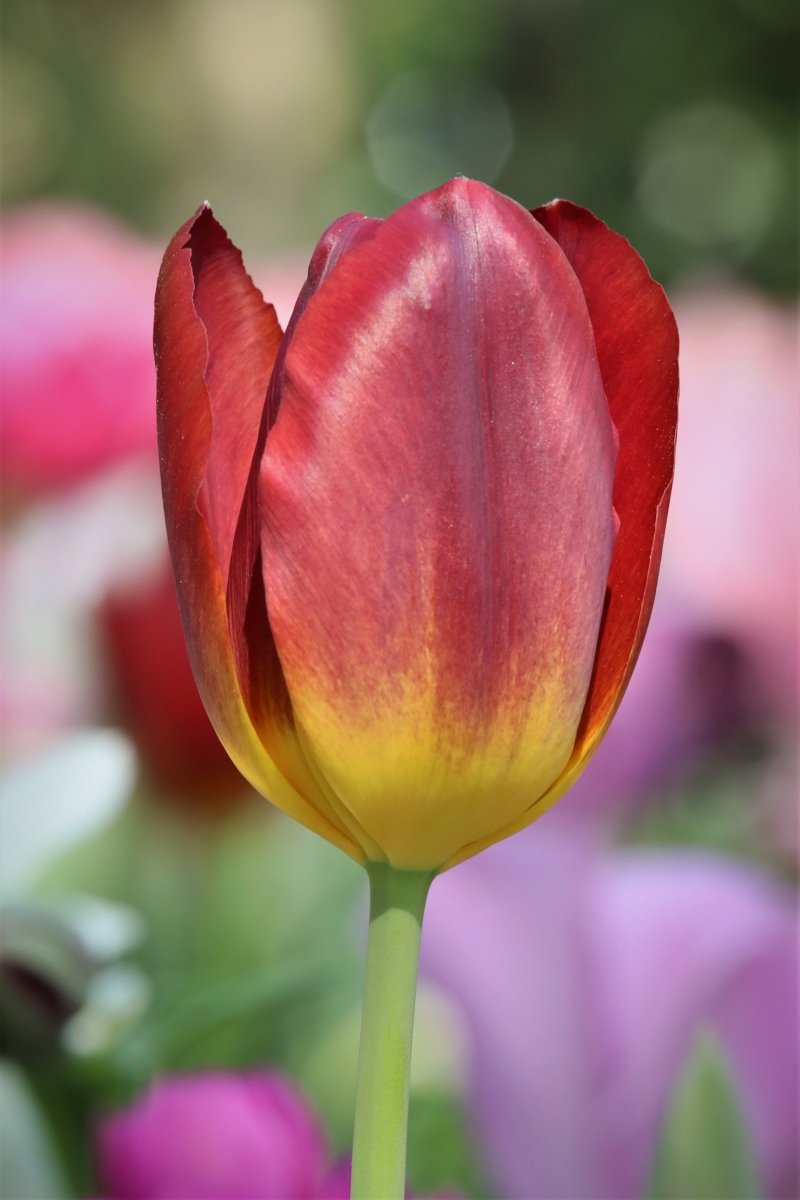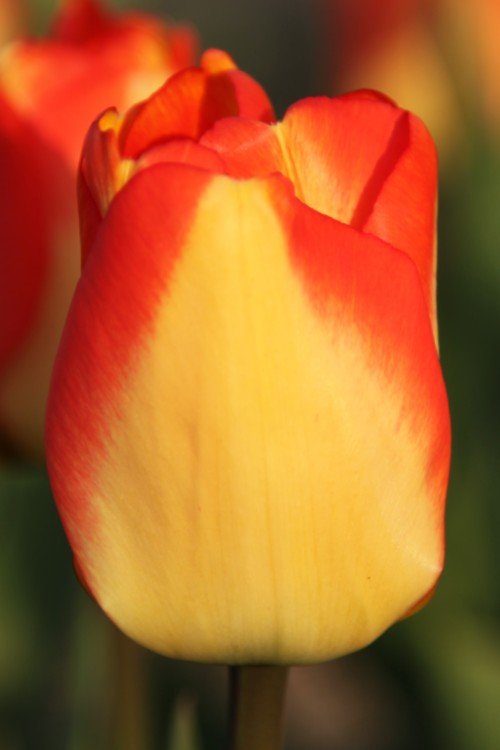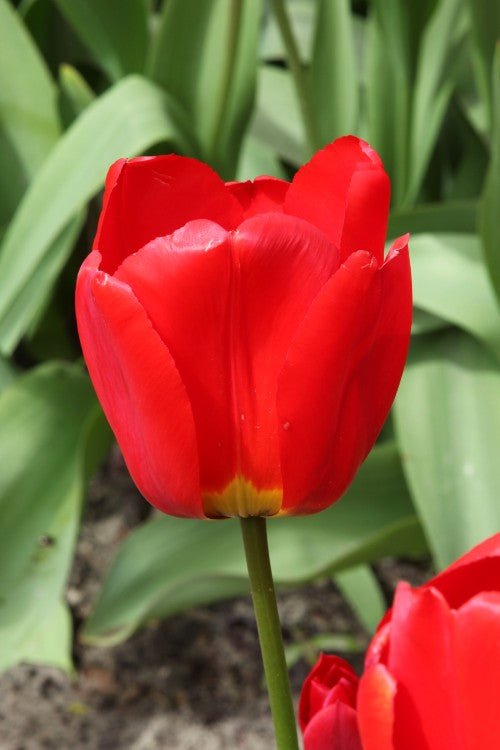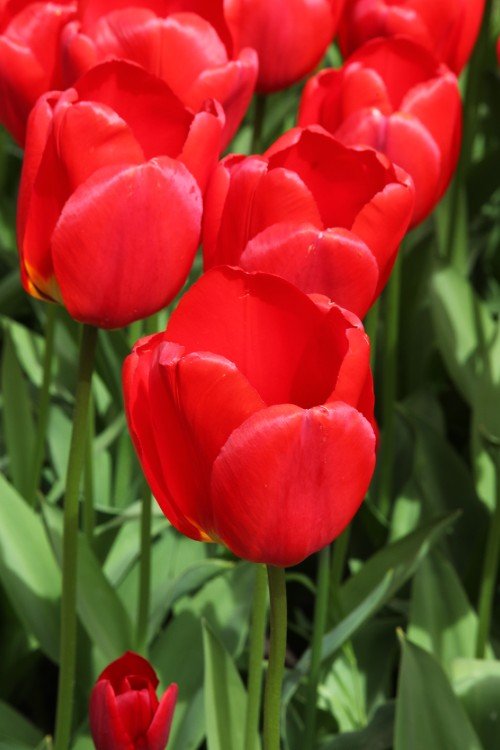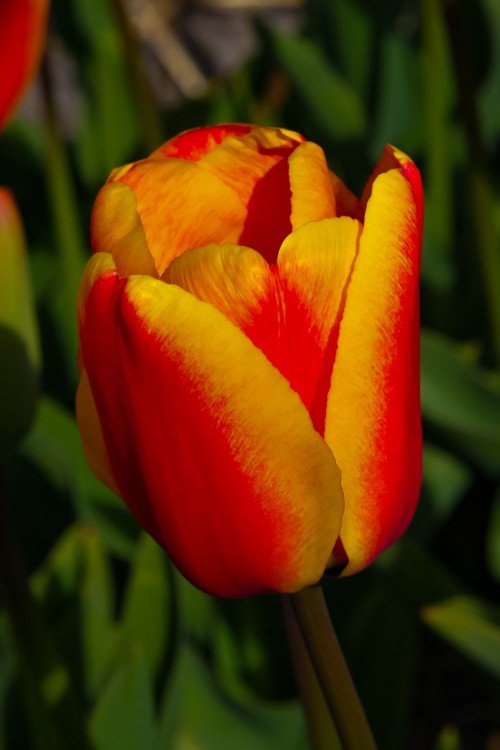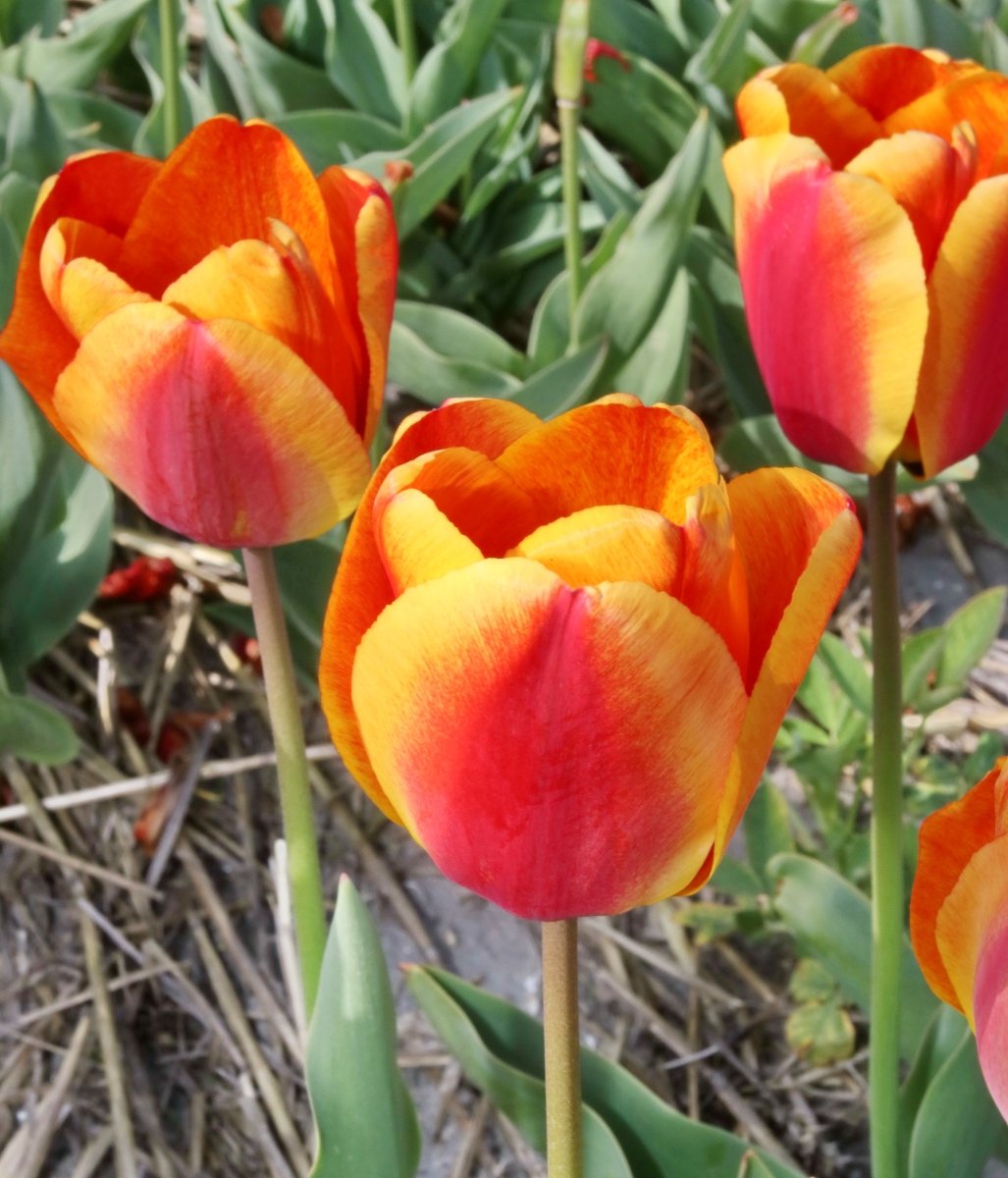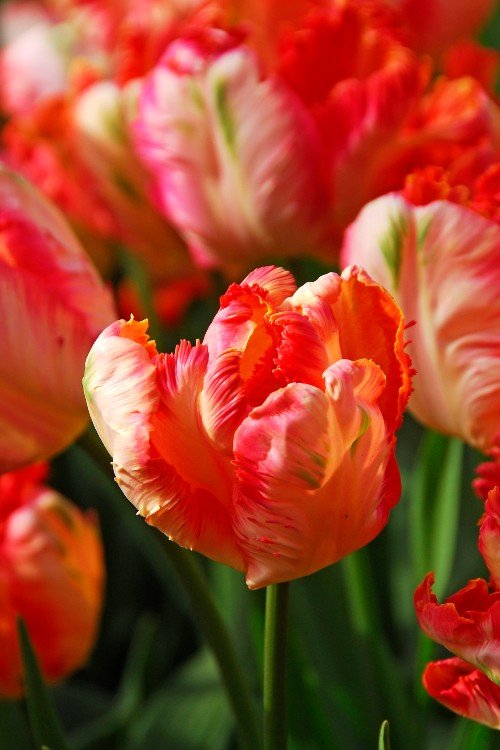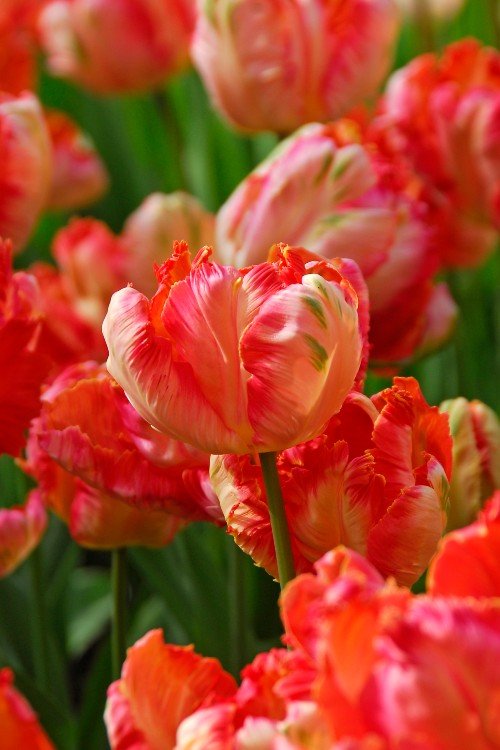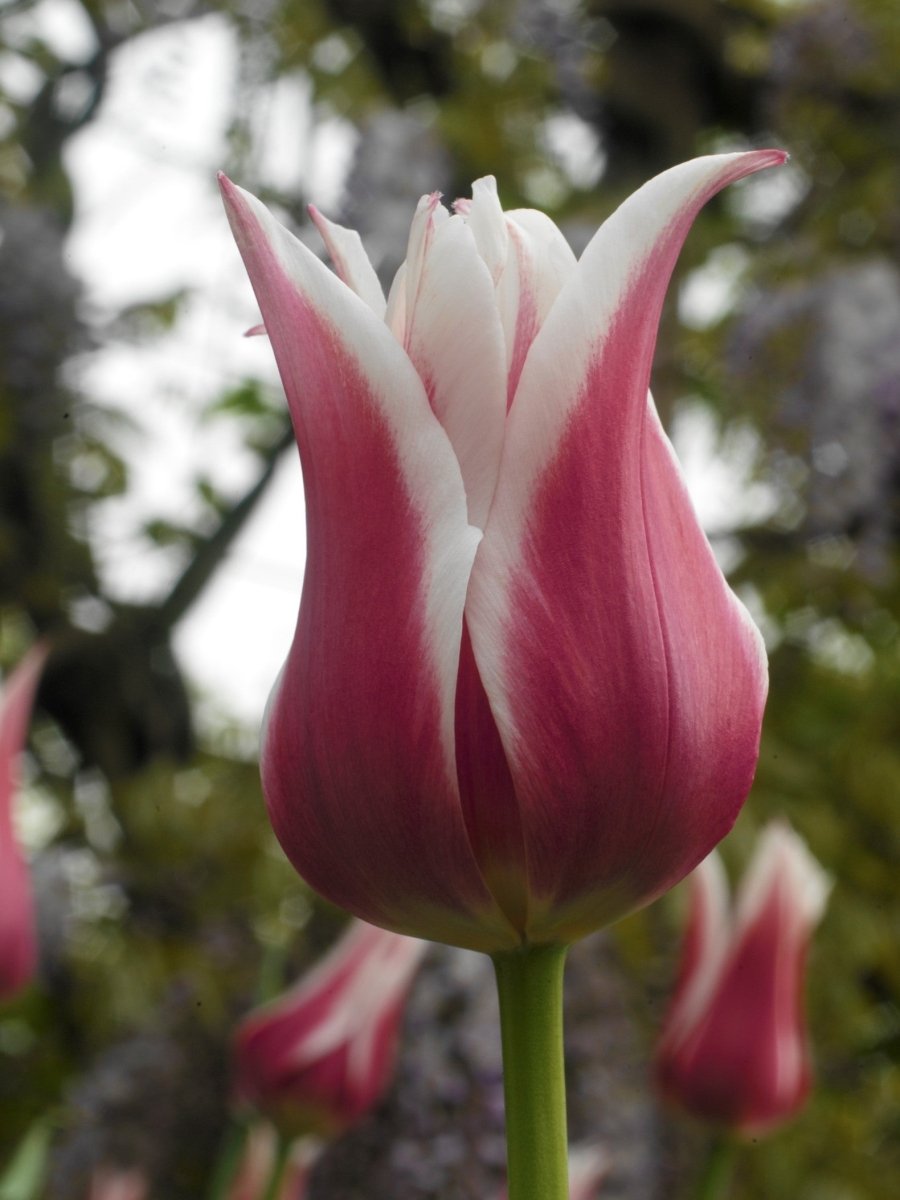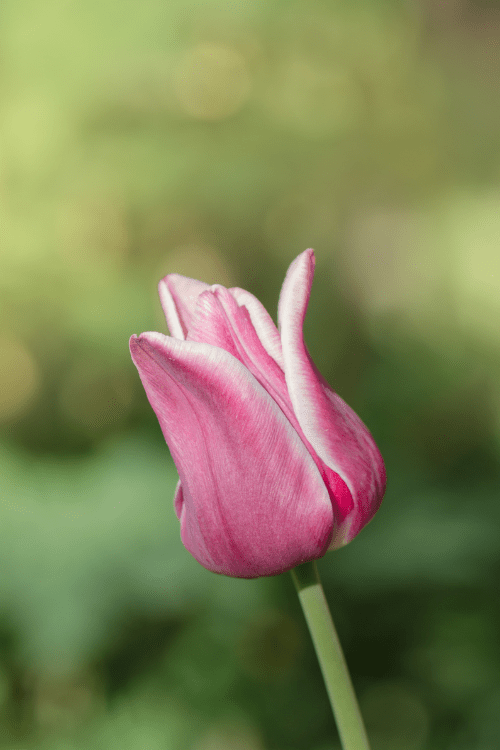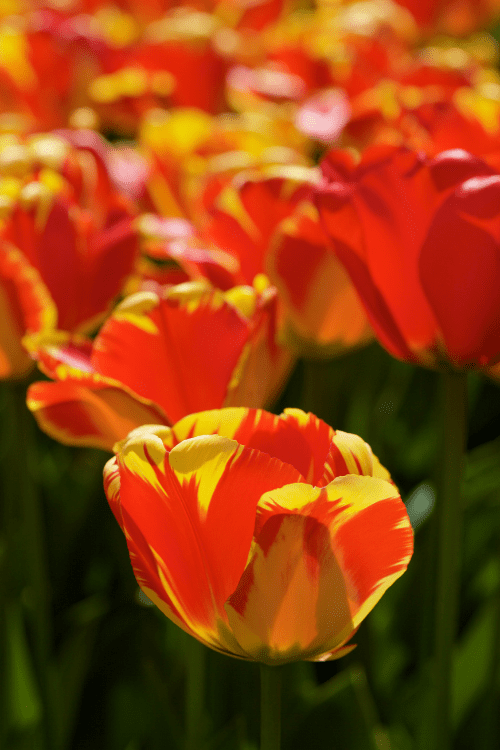Explore the Tulip Collection - Spring Flowering bulbs
Sort by:
About Alibi
The Triumph Tulip Alibi is a must-have addition to any garden. With its vibrant, bold tones of purple and sturdy stems, this tulip variety brings energy and life to your outdoor space. The mix of bright hues and elegant shape makes it a standout choice for borders, flower beds, or containers. Whether you're a seasoned gardener or a beginner, these tulips are easy to care for and perfect for adding a pop of color to your garden.
-
Vibrant colors: a striking blend of purples
-
Strong stems: perfect for windy areas, as they stand tall and firm.
-
Long-lasting blooms: enjoy beautiful flowers throughout spring.
-
Easy to grow: low maintenance and great for beginner gardeners.
-
Deer resistant: keeps your tulips safe from curious animals.
How to plant and take care of Triumph Tulip Alibi:
-
Planting depth: plant bulbs 6-8 inches deep in well-drained soil.
-
Spacing: space bulbs about 4-6 inches apart to allow for growth.
-
Sunlight: choose a sunny spot for full bloom potential.
-
Watering: water the bulbs after planting, but avoid over-watering. Keep the soil moist but not soggy.
-
Fertilization: use a balanced fertilizer in the spring to encourage strong, healthy flowers.
-
Post-bloom care: after blooming, let the leaves die back naturally to help nourish the bulb for next season.
About Alison Bradley
The Double Early Tulip Alison Bradley is a stunning addition to any spring garden. With its deep burgundy petals and full, peony-like blooms, this tulip brings rich color and classic charm to flower beds, borders, and containers. Its early bloom time makes it one of the first tulips to brighten your garden after winter.
-
Rich burgundy Purple double blooms with layered petals
-
Early flowering variety, blooms in mid to late spring
-
Compact growth, perfect for small gardens or pots
-
Strong stems, ideal for cut flower arrangements
-
Cold-hardy and reliable year after year
How to plant and take care of Double Early Tulip Alison Bradley:
-
Plant bulbs in autumn, about 4 to 6 inches deep
-
Choose a sunny or lightly shaded spot with well-drained soil
-
Space bulbs about 4 inches apart for best results
-
Water after planting and keep soil slightly moist during growth
-
Remove spent flowers to encourage bulb health
-
Allow foliage to die back naturally before removing
About Amberglow
Don't miss out on the chance to add the Tulip Amberglow to your garden. This exquisite tulip variety showcases a warm amber hue that adds a touch of elegance and beauty to your outdoor space.
- Unique two-colored Tulip
- Graceful and elegant form
- Ideal for formal and informal gardens
- Adds a touch of warmth and beauty to any space
How to plant and care for Amberglow
- Choose a well-drained location with full sun to partial shade.
- Plant bulbs in the fall, around 6-8 weeks before the first frost.
- Dig a hole that is two to three times the depth of the bulb and place it with the pointed end facing up.
- Space the bulbs about 4-5 inches apart to allow for healthy growth.
- Water thoroughly after planting and keep the soil moist during the growing season.
- Apply a balanced fertilizer during early spring to encourage robust blooms.
- Remove spent flowers to promote the plant's energy towards bulb development.
- After blooming season, allow the foliage to wither naturally before trimming it back.
About American Dream
Get ready to transform your garden with the mesmerizing beauty of Tulip American Dream. With its striking red and yellow petals, this tulip variety is sure to captivate anyone who sets eyes on it. Its unique color combination makes it a standout choice for adding a touch of elegance to your flower beds, borders, or containers.
- Striking red and yellow petals for a captivating display
- Hardy and reliable variety that blooms year after year
- Ideal for flower beds, borders, and containers
- Adds an elegant touch to any garden or landscape
How to plant and take care of American Dream Tulip
- Choose a sunny location with well-draining soil
- Plant the bulbs in the fall, about 6 inches deep and 4-5 inches apart
- Water thoroughly after planting and keep the soil moist but not waterlogged
- Apply a layer of mulch to help retain moisture and suppress weeds
- Fertilize in early spring with a balanced flower fertilizer
- Deadhead the flowers after they fade to promote healthy growth
- Allow the foliage to die back naturally before removing it
- Protect the bulbs from extreme cold or excessive moisture during winter
About André Rieu
The Single Late Tulip André Rieu is a stunning addition to any garden, with its elegant, soft purple petals and sturdy stems. Known for its long-lasting blooms, this tulip creates a captivating scene in spring. Whether planted in garden beds or containers, the André Rieu variety adds a touch of sophistication to your outdoor space.
-
Elegant appearance: beautiful, soft purple petals with a delicate shape.
-
Long-lasting blooms: enjoy vibrant flowers that last well into late spring.
-
Tall stems: perfect for creating height and structure in garden displays.
-
Resilient growth: tolerates different weather conditions and thrives in most soil types.
-
Versatile: great for borders, flower beds, or as a cut flower in bouquets.
How to plant and take care of Single Late Tulip André Rieu:
-
Planting depth: plant bulbs about 6-8 inches deep in well-draining soil.
-
Spacing: space bulbs 4-6 inches apart to give them room to grow.
-
Sunlight: ensure the tulips get full sun for the best blooms.
-
Watering: water the bulbs after planting, then keep the soil moderately moist as they grow.
-
Fertilization: use a balanced fertilizer in early spring for healthier blooms.
-
Winter care: after blooming, allow the foliage to die back naturally to help the bulbs store energy for next year.
About Angelique
Angelique is one of our most popular Tulips and we totally get why. With its delicate, pink petals and captivating hues, this graceful flower will add a touch of elegance to any garden or floral arrangement. Angelique is very suitable for every kind of garden.
- Delicate and graceful tulip variety
- Captivating hues and exquisite beauty
- Perfect for garden displays and floral arrangements
- Adds an elegant touch to any setting
How to plant and take care of Angelique
- Choose a sunny location with well-draining soil
- Plant bulbs in the fall, about 4-6 inches deep and 4-5 inches apart
- Water regularly, keeping the soil evenly moist but not waterlogged
- Apply a balanced fertilizer during the growing season
- Deadhead faded flowers to promote continuous blooming
- Allow the foliage to die back naturally after flowering
- Protect bulbs from excessive moisture during dormant periods
- Enjoy the enchanting beauty of Tulip Angelique year after year with proper care
About Apeldoorn
Don't miss out on the stunning beauty of the Tulip Apeldoorn. Its striking red petals make a bold statement that will capture attention. With its easy care requirements, the Tulip Apeldoorn is perfect for both experienced and novice gardeners alike.
- Striking red petals
- Adds a bold and captivating touch to any garden or floral arrangement
- Easy to grow and maintain
- Ideal for both experienced and novice gardeners
- Thrives in full sun or partial shade
How to plant and take care of Apeldoorn
- Choose a well-draining location in your garden that receives ample sunlight.
- Dig a hole about 6 inches deep and place the bulb with the pointed end facing upwards.
- Space the bulbs about 4-5 inches apart to allow them room to grow.
- Cover the bulbs with soil and gently firm it down.
- Water thoroughly after planting and keep the soil evenly moist.
- Once the flowers bloom, remove the dead blooms to encourage further growth.
- After the tulips have finished blooming, allow the foliage to die back naturally.
- Protect the bulbs from extreme temperatures and pests during their dormant period.
About Apeldoorn Elite
Don't miss out on the beauty and elegance of Tulip Apeldoorn Elite. This exquisite variety boasts eye-catching red petals with yellow edges, creating a striking display that will captivate your senses.
- Brilliant red petals with yellow edges for a stunning visual impact
- Sturdy stems ensure long-lasting blooms
- Ideal for both garden beds and containers
- Easy to grow, suitable for beginners and experienced gardeners alike
- Perfect for adding vibrant color to your spring garden
How to plant and take care of Apeldoorn Elite
- Choose a sunny location with well-drained soil
- Plant bulbs in the fall, approximately 6 inches deep and 4-5 inches apart
- Water thoroughly after planting and keep the soil evenly moist
- Apply a layer of mulch to help conserve moisture and suppress weeds
- Deadhead spent flowers to encourage more blooms
- After flowering, allow the foliage to wither and yellow before removing
- For optimal results, fertilize with a balanced bulb fertilizer in early spring
About Apricot Emperor
Add a touch of regal elegance to your garden with the enchanting Tulip Apricot Emperor. This captivating flower will surely steal the spotlight with its vibrant apricot hues and graceful form.
- Majestic apricot-colored blooms
- Striking and elegant appearance
- Hardy and reliable variety
- Ideal for borders, beds, or containers
- Perfect for both novice and experienced gardeners
How to plant and take care of Apricot Emperor
- Choose a sunny location with well-draining soil
- Plant bulbs in the fall, around 6-8 weeks before the first frost
- Dig a hole 6 inches deep and place the bulb pointy side up
- Space bulbs 4-5 inches apart
- Water thoroughly after planting and keep the soil moist but not waterlogged
- Apply a balanced fertilizer once shoots emerge
- Remove spent flowers to encourage more blooms
- After blooming, allow the foliage to die back naturally
- Protect bulbs from excessive moisture during dormant periods
About Apricot Foxx
Bring the beauty of Tulip Apricot Foxx to your garden and enjoy its stunning blooms year after year. Its stunning color and graceful form make it a perfect addition to any landscape or floral arrangement.
- Striking apricot-colored blooms
- Elegant and graceful form
- Adds a touch of sophistication to your garden
- Ideal for both landscapes and floral arrangements
- Easy to grow and maintain
How to plant and take care of Apricot Foxx
- Choose a well-draining location with full or partial sunlight.
- Plant bulbs in the fall, before the first frost, at a depth of 6 inches.
- Space bulbs about 4-5 inches apart.
- Water thoroughly after planting and keep the soil consistently moist during the growing season.
- Apply a balanced fertilizer once shoots emerge.
- Deadhead faded flowers to promote continuous blooming.
- Allow foliage to yellow and wither naturally before removing it.
- Protect bulbs from excessive moisture and rot by ensuring proper drainage.
About Apricot Parrot
Enhance your garden with the vibrant beauty of the Tulip Apricot Parrot! With its unique, eye-catching blooms, this tulip variety will surely be the centerpiece of your flower bed.
- Striking apricot-colored petals with elegant fringed edges
- Large, showy blooms that make a bold statement
- Long-lasting flowers that bring color to your garden throughout spring
- Excellent for cut flower arrangements, adding a touch of elegance to any room
How to plant and take care of Apricot Parrot
- Choose a sunny location in your garden with well-draining soil
- Plant bulbs in the fall, around 6 inches deep and 4-5 inches apart
- Water thoroughly after planting and keep the soil moist but not waterlogged
- Provide regular watering during dry spells, especially during the growing season
- Apply a balanced fertilizer in early spring to promote healthy growth
- Deadhead faded flowers to encourage the plant to put energy into new blooms
- After the tulips have finished flowering, allow the foliage to wither naturally before removing it
- Consider lifting and dividing bulbs every few years to maintain their vigor
About Apricot Pride
Darwin Hybrid Tulip Apricot Pride is a stunning spring-blooming tulip that adds warmth and elegance to any garden. With its soft apricot petals and strong stems, it brings both beauty and reliability to your flower beds. These tulips are known for their large, long-lasting blooms and are perfect for borders, cut flower arrangements, or mass plantings.
-
Soft apricot color with a hint of pink and yellow tones
-
Strong, tall stems ideal for windy spots and cut flowers
-
Blooms in mid to late spring for a long-lasting display
-
Returns yearly with proper care thanks to hardy Darwin hybrid genetics
-
Blends well with pastel and bold-colored spring flowers
How to plant and take care of Darwin Hybrid Tulip Apricot Pride:
-
Plant bulbs in fall, about 6 inches deep and 4-5 inches apart
-
Choose a spot with full sun or light shade
-
Use well-draining soil to prevent bulb rot
-
Water after planting and keep soil slightly moist during growing season
-
Cut back faded flowers but leave leaves to die back naturally
-
Apply a light bulb fertilizer in early spring for stronger blooms
About Aveyron
Meet the Tulip Aveyron, a flower that brings charm to your garden. With its pretty color and lovely shape, Aveyron is like a natural artist painting your outdoor space with beauty. It is a Double Late Tulip, which means it has double petals and blooms in late Spring. Let's explore the simplicity and grace of this tulip variety!
- Colorful delight: Aveyron has deep hot pink petals, making your garden pop with color.
- Strong and tall: watch Aveyron stand tall and proud, adding a special touch to your flower beds.
- Lasting beauty: enjoy Aveyron's flowers for a long time, keeping your garden bright throughout spring.
- Easy everywhere: Aveyron is tough and grows well in different climates, making it perfect for gardens everywhere.
How to plant and take care of Aveyron
- Plant bulbs in well-drained soil during the fall, ensuring they receive ample sunlight.
- Space bulbs about 4-6 inches apart with the pointed end facing upward.
- Cover with soil, water thoroughly, and await the magical emergence in spring.
- Water moderately, keeping the soil consistently moist but not waterlogged.
- Apply a balanced fertilizer in early spring to support healthy growth.
- Remove spent flowers to encourage continuous blooming.
- After blooming, allow the foliage to wither naturally to nourish the bulb for the next season.
About Avignon
Unleash the vibrant beauty of Tulip Avignon in your garden! These exquisite flowers will captivate your senses with their rich, pink-red with orange petals.
- Striking pink-red with orange petals
- Gorgeous cup-shaped blooms
- Sturdy stems for lasting beauty
- Perfect for borders, beds, and containers
- Ideal for spring garden displays
How to plant and take care of Avignon
- Choose a sunny location with well-draining soil.
- Plant bulbs in the fall, 6 inches deep and 4-5 inches apart.
- Water thoroughly after planting.
- Keep soil evenly moist but not waterlogged.
- Apply a balanced fertilizer in early spring.
- Deadhead spent blooms to encourage more flowering.
- After blooming season, allow the foliage to wither naturally.
- Protect from extreme cold temperatures with mulch.
About Ballade
Bring the captivating beauty of Tulip Ballade to your garden and be enchanted by its stunning colors and effortless charm.
- Vibrant and elegant: The Tulip Ballade boasts striking shades of purple and white, adding a touch of sophistication to any landscape.
- Long-lasting blooms: Enjoy weeks of breathtaking beauty as the Tulip Ballade's flowers gracefully open and stay fresh for an extended period.
- Reliable performer: This tulip variety is known for its strong stems, ensuring that the blooms stand tall and proud even in adverse weather conditions.
- Versatile usage: Whether you're planting them in beds, borders, or containers, the Tulip Ballade's beauty shines through, making it a versatile choice for various gardening projects.
How to plant and take care of Ballade
- Planting: Choose a sunny location with well-drained soil. Dig a hole 8 inches deep and place the tulip bulb pointy side up. Cover with soil and water thoroughly.
- Watering: Provide regular watering during the growing season, keeping the soil moist but not waterlogged.
- Fertilization: Apply a balanced slow-release fertilizer in early spring to promote healthy growth.
- Pruning: After the blooms fade, remove the flower stalk but let the foliage wither naturally. This allows the tulip bulb to store energy for next year's growth.
- Protection: Protect the tulip bulbs from pests such as squirrels or rabbits by using wire mesh or planting deterrent bulbs nearby.
- Winter care: In colder regions, cover the planting area with mulch to insulate the bulbs during the winter months.
About Banja Luka
Bring the enchanting beauty of Tulip Banja Luka to your garden today and enjoy its stunning blooms year after year. Known for its vibrant colors and graceful blooms, this variety is a must-have for any flower enthusiast. Whether you're a seasoned gardener or just starting out, Tulip Banja Luka will add a touch of elegance to your outdoor space.
- Striking and vibrant colors that create a captivating display
- Graceful and elegant blooms that bring a touch of sophistication
- Hardy and easy to grow, perfect for beginners and experienced gardeners alike
- Versatile flower that can be planted in borders, beds, or containers
- Ideal for springtime, bringing a burst of color after the winter months
How to plant and take care of Banja Luka
- Choose a sunny location with well-draining soil for optimal growth
- Plant the bulbs in the fall, approximately 6 inches deep and 4-5 inches apart
- Water thoroughly after planting to settle the soil
- Keep the soil consistently moist but not waterlogged during the growing season
- Apply a balanced fertilizer in early spring to promote healthy growth
- Deadhead faded blooms to encourage more flowers and prevent seed formation
- After the blooming period, allow the foliage to wither and yellow naturally before removing it
- Consider lifting and dividing the bulbs every few years to maintain their vigor
About Batalinii Bright Gem
Find out why we love this Batalinii Bright Gem so much. These yellow small tulips are perfect for borders, or in the front of the garden and for sure to add a burst of color and elegance to any outdoor space.
- Vibrant and eye-catching blooms
- Compact and sturdy growth habit
- Long-lasting flowers that bloom in early spring
- Gorgeous shades of bright yellow
- Perfect for borders, containers, and flower beds
How to plant and take care of Batalinii Bright Gem
- Choose a well-draining location with full or partial sunlight
- Dig a hole that is 6 inches deep
- Place the bulb in the hole, pointed side up
- Cover the bulb with soil and gently pat it down
- Water thoroughly after planting and keep the soil moist but not waterlogged
- Fertilize with a balanced bulb fertilizer in early spring
- Remove faded flowers to promote continuous blooming
- Mulch the soil to help retain moisture and suppress weeds
- Protect the bulbs from extreme cold by covering them with a layer of mulch or straw in winter
About Bella Blush
Transform your garden with the charming Tulip Bella Blush. This delightful flower brings a touch of beauty to any space. With soft pink and yellow-orange petals, Bella Blush is a must-have for all garden lovers. Its strong stem makes it last longer, and it blooms early in spring. Add a pop of color effortlessly with Bella Blush!
- Sturdy and resilient: this tulip variety boasts a robust stem, ensuring longevity and resistance against the elements.
- Versatile garden companion: ideal for borders, containers, or mixed flower beds, Bella Blush complements various garden styles.
- Early bloomer: experience the beauty of Bella Blush early in the spring, heralding the arrival of the warmer seasons.
- Low maintenance: perfect for both beginners and seasoned gardeners, Bella Blush requires minimal care for maximum visual impact.
How to plant and take care of Bella Blush
- Planting depth: place bulbs about 6 inches deep, with the pointed end facing up.
- Spacing: allow 4-6 inches of space between each bulb to ensure proper growth and airflow.
- Sunlight requirements: choose a well-draining location with full to partial sunlight for optimal blooming.
- Watering: keep the soil consistently moist but not waterlogged, especially during the growing season.
- Fertilization: apply a balanced fertilizer in early spring to support robust growth.
- Post-bloom care: once the flowers fade, deadhead spent blooms to encourage the plant's energy for the next season.
FAQs

